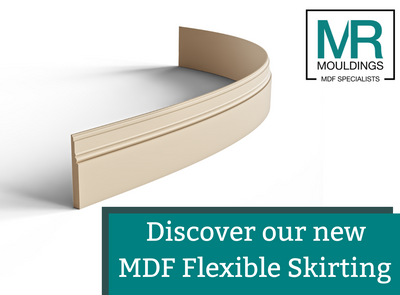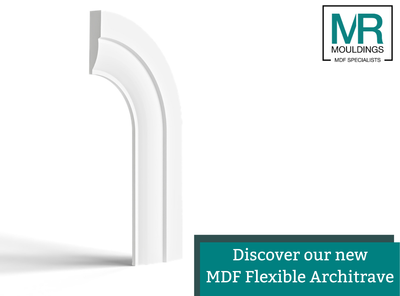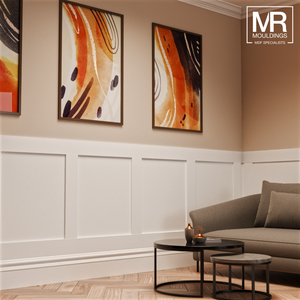
Is MDF Sustainable? Understanding the Eco Impact of Engineered Wood
In a world increasingly focused on sustainability, it’s only natural to question the environmental impact of the materials we bring into our homes. Whether you’re renovating, fitting new skirting boards, or designing a stylish wall panel feature, you may be wondering: is MDF sustainable?
Yes, MDF is considered sustainable when responsibly sourced. It’s made from recycled wood fibres, reducing timber waste, and manufactured to low-emission standards like E1 or E0. While not biodegradable, its durability and efficient use of materials make it an eco-conscious choice, especially when using moisture-resistant MDF from trusted suppliers.
At MR Mouldings, we work with moisture-resistant MDF every day, and we’re proud to supply products that aren’t just built to last, but also made with sustainability in mind. Here's everything you need to know about MDF’s environmental credentials.
What Is MDF Made From?
MDF (Medium-Density Fibreboard) is an engineered wood product created from fine wood fibres combined with wax and resin. These fibres are typically sourced from:
-
Sawmill byproducts
-
Recycled softwood
-
Sustainably managed plantation timber
The result is a dense, smooth board that’s ideal for detailed mouldings, trims, and interior joinery. Because MDF repurposes wood that might otherwise be discarded, it makes efficient use of timber resources, a major plus in sustainability terms.
Is MDF Sustainable? A Balanced Perspective
✅ The Sustainability Advantages
1. Made From Recycled Wood Fibres
Rather than using whole trees, MDF production uses leftovers from other timber processes. This repurposing of waste significantly reduces raw material demand.
2. Maximises Sawmill Efficiency
Offcuts, chips, and sawdust are given a second life, helping to reduce the amount of wood waste heading to landfill.
3. Long-Lasting Performance
High-quality MDF, especially moisture-resistant MDF like the kind we supply at MR Mouldings, can last for years without warping, swelling, or cracking. This longevity means fewer replacements and less waste.
4. Cleaner Production Than Ever
Many modern MDF factories use closed-loop systems, energy-efficient machinery, and low-emission resin technology, resulting in a cleaner, more eco-conscious product.
⚠️ Points to Consider
Not Biodegradable
Unlike solid wood, MDF doesn't break down easily in nature. However, its engineered stability makes it suitable for long-term use, which offsets this drawback for many applications.
Limited Recyclability
MDF isn’t always accepted in household recycling streams. While some industrial facilities can repurpose MDF into acoustic boards or fuel, its recyclability depends on local infrastructure.
Formaldehyde Content
Some MDF uses formaldehyde-based resin. However, most high-quality MDF today, like the boards used by MR Mouldings, meets E1 or E0 standards, meaning low or near-zero emissions that comply with UK and EU safety regulations.
What About Moisture-Resistant MDF?
At MR Mouldings, we only supply moisture-resistant MDF (MR MDF) across our range of skirting boards, architraves, and trims. These boards use a specialised resin to improve resistance to humidity and water exposure.
From a sustainability perspective:
-
MR MDF has greater durability, meaning it’s less likely to be replaced or disposed of early
-
While harder to recycle, its longer lifespan is a net positive for the environment
-
Ideal for kitchens, bathrooms, and utility rooms, spaces that often demand more frequent replacements when poor-quality materials are used
MDF vs Other Materials: Which Is More Sustainable?
|
Material |
Sustainability Pros |
Considerations |
|
MDF |
Made from recycled fibres, efficient production |
Not biodegradable, limited recycling |
|
Solid Wood |
Natural, renewable, biodegradable |
Slower to grow, more expensive, more waste |
|
PVC Trim |
Durable, lightweight |
Fossil-fuel based, non-renewable |
|
Plywood |
Strong, some made with formaldehyde-free resin |
Often uses virgin timber |
Verdict: MDF offers a sustainable middle ground, especially when sourced from responsible suppliers and used in long-lasting applications like MR Mouldings’ interior mouldings.
Is MDF Recyclable?
MDF can be repurposed or used in industrial recycling processes, but household recycling centres don’t always accept it due to its resin content.
That said, many waste wood services and skip hire companies will accept MDF as non-hazardous waste wood, meaning it can be safely used for:
-
Waste-to-energy fuel
-
Animal bedding boards
-
Industrial fillers and composites
Most importantly, when you invest in well-made MDF products, like our profiles at MR Mouldings, you’ll reduce the need for early replacement, making your home more sustainable over the long term.
What to Look For in Sustainable MDF
If sustainability matters to you, here’s what to check when buying MDF:
-
E1 or E0 rated (low formaldehyde emissions)
-
FSC or PEFC certification (responsibly managed forests)
-
UK-manufactured boards (lower transport-related emissions)
-
Durability (moisture resistance and strength reduce waste)
At MR Mouldings, our MDF ticks all these boxes, and we’re committed to supplying high-quality, moisture-resistant MDF mouldings you can trust.
How MR Mouldings Supports Sustainable Choices
We’re proud to do things the right way. Here’s how we put sustainability into practice:
-
Only use moisture-resistant MDF for durability and performance
-
Source from trusted UK manufacturers to reduce emissions
-
Offer advice to help customers order efficiently and avoid waste
-
Package and ship orders responsibly, with minimal materials where possible
-
Encourage clients to invest in products built to last, not replace
When you choose MR Mouldings, you’re choosing more than just quality trim, you’re supporting responsible practices that put performance and environmental care side by side.
FAQs
Is MDF environmentally friendly?
Yes, when sourced responsibly. MDF uses recycled wood fibres, reduces timber waste, and is manufactured to low-emission standards like E1 or E0.
Can MDF be recycled?
Not in all areas. While MDF is not typically accepted in household recycling, some commercial facilities can repurpose it.
Is moisture-resistant MDF sustainable?
Yes. Its longer lifespan and resistance to damage reduce the need for frequent replacements, making it a smart choice for sustainable interiors.
Is MDF better than solid wood for the environment?
In many cases, yes. MDF makes efficient use of recycled fibres, whereas solid wood requires harvesting mature trees. For painted finishes, MDF is often the greener option.
What makes MDF from MR Mouldings a sustainable choice?
We only supply moisture-resistant MDF, sourced from UK manufacturers, and offer consistent, long-lasting products that minimise waste.
Final Thoughts
So, is MDF sustainable? In short, yes, especially when you choose the right kind. By using recycled fibres, producing less waste, and offering long-term performance, MDF is a smart, practical, and environmentally conscious choice for modern interiors.
At MR Mouldings, we’re proud to supply moisture-resistant MDF mouldings that combine exceptional quality with responsible sourcing. Browse our range online or get in touch with our team for honest advice on your next project.




